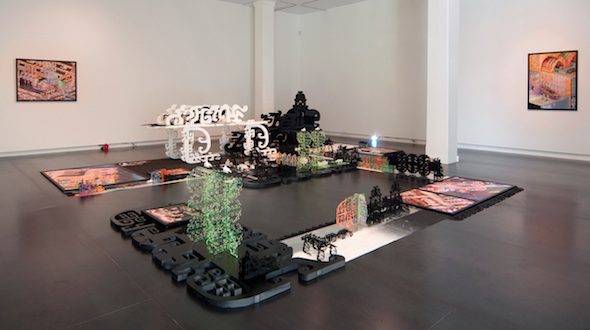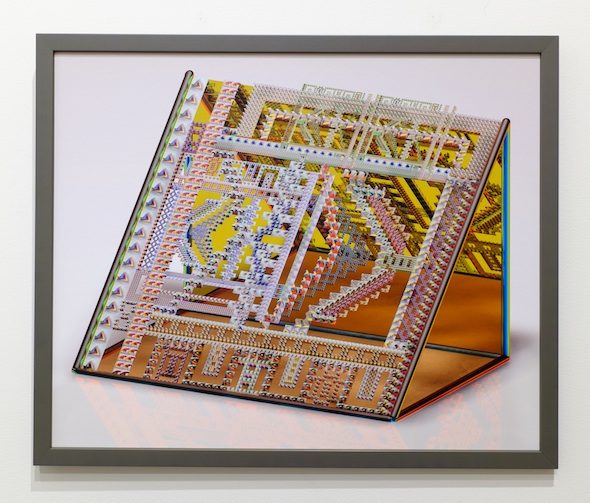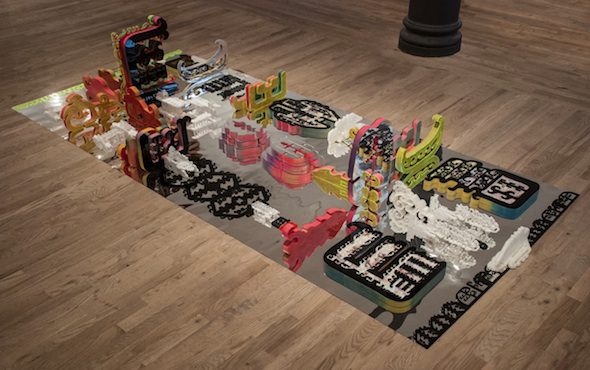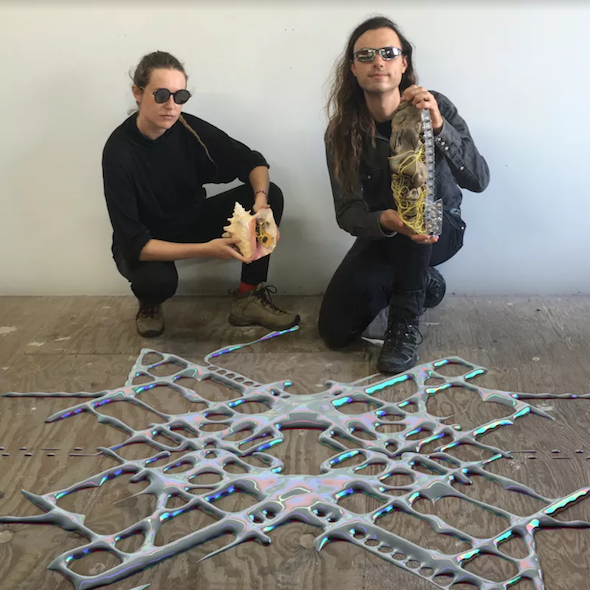Light regulates us. It allows us to understand the passage of time; we see light as energy indicating a life force. Brenna Murphy‘s elaborate plans of digital perplexity sit somewhere between the real and the unimaginable, shifting between the realms of architectural phosphorescent drawings and burnished landscapes. Murphy offers us the chance to feast our eyes on a digital futuristic ecstasy, where the sun never sets and the radioactive colour hues are nothing short of our sci-fi daydreams. Working with digital drawings, analog light-audio feedback systems and a strongly ceremonial or ritualistic discourse as part of her collective MSHR, Murphy’s practice circumnavigates the URL, IRL, with the ease of an innovative native. We talked to her about the fundamental parameters of reality, trance as a way of working and pure symbols in the western world.

Brenna Murphy: ‘Lattice Face Parameter Chant’, 2013 // Courtesy of the artist
Penny Rafferty: Your work seems to blur the boundaries of physical and digital space.
Brenna Murphy: I think those boundaries are already completely blurred. I’m exploring those intersecting spaces, the knotted pathways interweaving virtual and physical. Ultimately, I’m interested in the shape of reality and/or the shape of consciousness and I think these shapes exist across physical and virtual dimensions. My method for exploring these spaces is to engage with them as a creative agent. Weaving material back and forth creates a sort of breadcrumb trail that I can follow through dimensions. I’m especially interested in how virtual space reveals the architecture of consciousness. Physical space is a given outside the human mind. But virtual space is a space invented by the human mind, so its parameters can reveal architectures that are so fundamental they can be hard to see.
PR: This lends itself to an inherent spiritual or mystic theme. Where do you draw this from?
BM: As a sentient being in this earthly realm, I have a deep and reverent curiosity about the fundamental parameters of this “reality”. For me, being an artist means inventing a series of exercises for myself to explore these parameters. Part of these exercises involves entering trance states, in which my mind is totally focused on aesthetic balance, leading to a sense of harmony with a consciousness beyond my own. But these ecstatic moments are just as important as the rest of my workflow, cultivating a daily practice around personal relationships, mundane errands, research, etc.

Brenna Murphy: ‘Crease Array Module’, 2015 // Courtesy of the artist

Brenna Murphy: ‘Glyph Garland’, 2014 // Courtesy of the artist
PR: How do you enter this trance-like state?
BM: My trance is a state of extreme focus, when my mind can’t wander around, but it is also bound up in a flow of energy. For me, making art is a way of entering this state. Creating shapes and colors and arranging them. It’s a striving toward balance: I’m arranging elements in a composition until its balanced and my mind can’t wander away from that process, like walking a tight rope. There’s an ecstasy there in being so wrapped up in the visual balance of spatial arrangements. Your mind becomes entangled in shapes outside itself.
PR: Personally I am always interested in the way you make the unreal real, but in my mind this also makes me question what are the aesthetics of reality are now.
BM: I think there is a trend toward unseeing the goopy ingredients of our physical reality in favor of receiving pure symbols. When you walk down the street, your attention is grabbed toward your phone screen, toward the billboards, toward the symbols on storefronts and street-signs. It can seem as if you are already walking through a virtual scape, only registering the symbolic/virtual content as neon on a black void. In my work, I’m interested in modelling this phenomenon in virtual space so that I can be more aware of it. And when I’m walking down the street, I try to strengthen my ability to see the goopiness instead of the symbols. I try to focus on the iridescent cobwebs and the dull surface quality of weathered plastic. Cultural aesthetics are always refining a language that eliminates the confusing filth.

MSHR, portrait // Courtesy of Brenna Murphy
PR: Can you tell me a little more about MSHR and its relation to your existing body of works?
BM: MSHR is the collective name for my ongoing collaborative practice with Birch Cooper. The collective began in 2011 as an offshoot from the larger art collective Oregon Painting Society. We work at the intersection of digital sculpture, analog circuitry and ceremonial performance. Our physical projects have largely revolved around analog light-audio feedback systems built from macro-arrangements of our sculptural synthesizers. Our performances enact these systems with a ritual structure. On the virtual side, we weave computer generated portraits of inter-dimensional entities that reflect our sonic shapes. MSHR’s work, Birch’s work and my work are like celtic knots that feed each other. Creative collaboration is such a gift because it creates a doorway to a meta-mind more complex than either of our own.
PR: What exactly is an analog light-audio feedback system?
BM: We build analog synthesizers that can be controlled by light sensors. Making sculptures embedded with light sensors that plug into the synthesizers, they build “color organs” that take the audio output of our synthesizers and turn on groups of light bulbs according to the frequency of the sound. By placing the sculptural light sensors near the lightbulbs, a light-audio feedback system unfolds, where the sound is controlled by the light and the light is controlled by the sound. In installations, sometimes we arrange these elements into static formations which create a kind of slowly changing undulating feedback pattern.
We have also created installations with this system that are interactive. For instance, in our installation ‘Ceremonial Chamber’, the lights were inside a table with a partially transparent surface. Visitors could slide sculptural light sensors across the top of the table to shift the feedback patterns. In our performances, we insert ourselves into this system, shifting the array of sculptural light sensors and lightbulbs to modulate the feedback.























